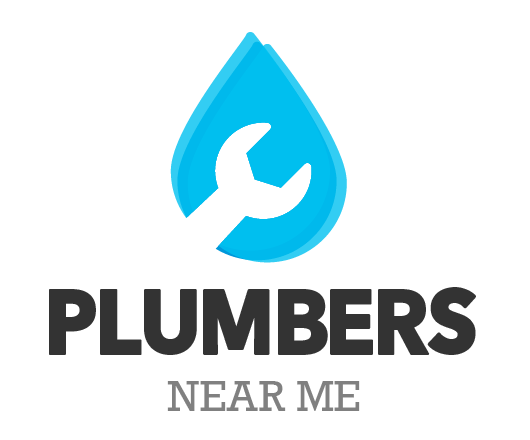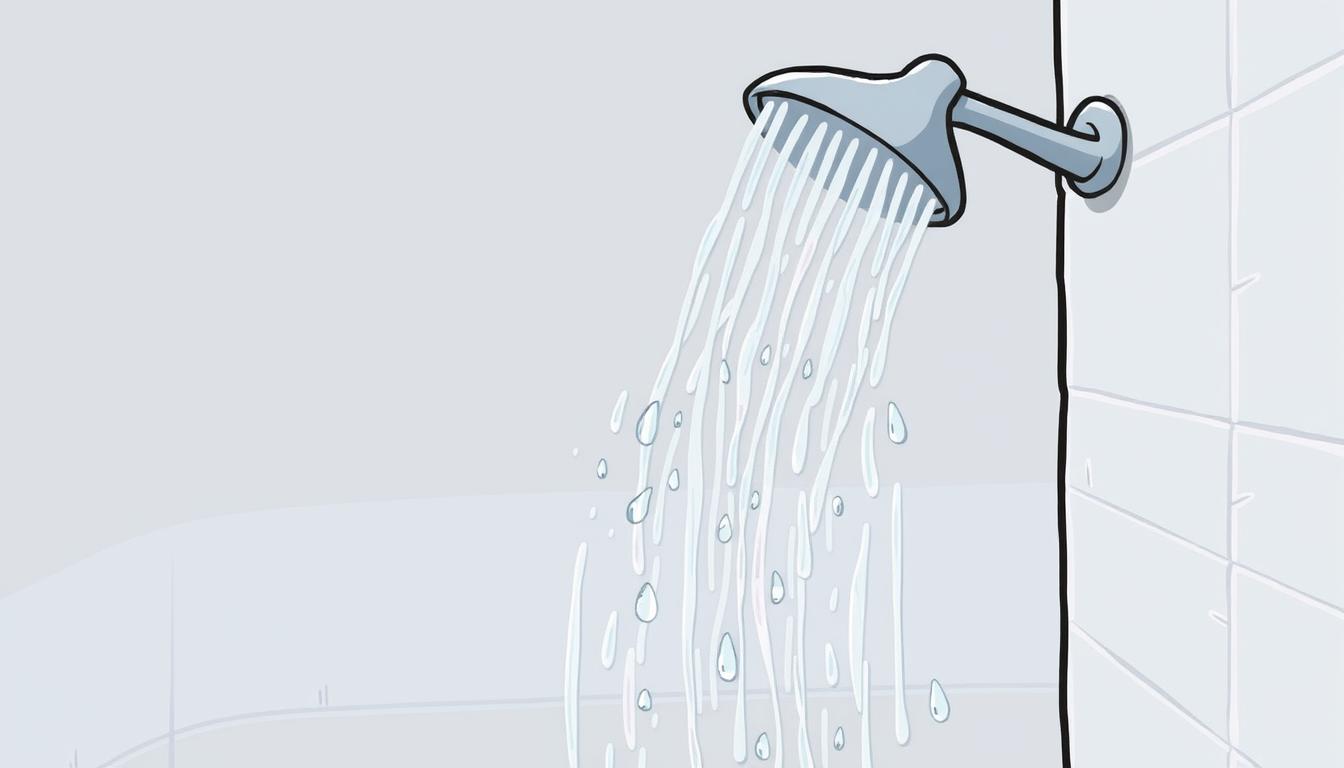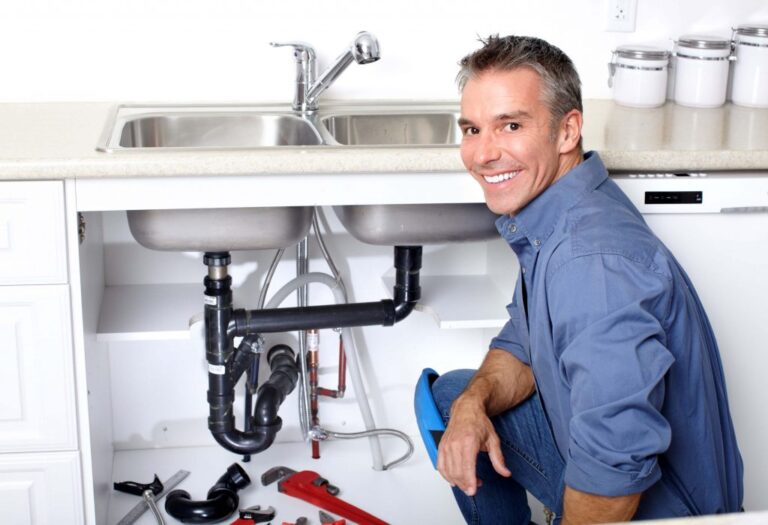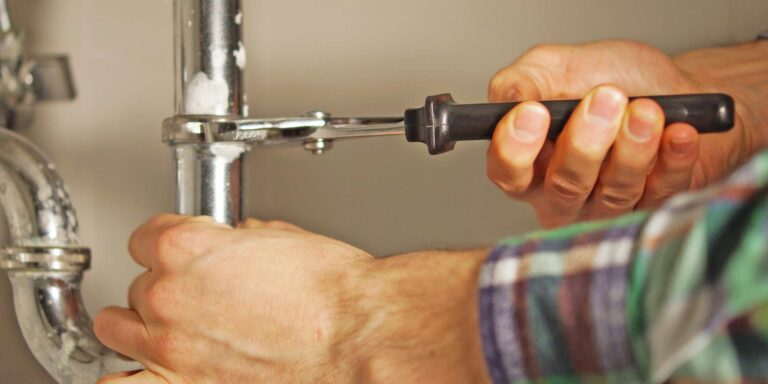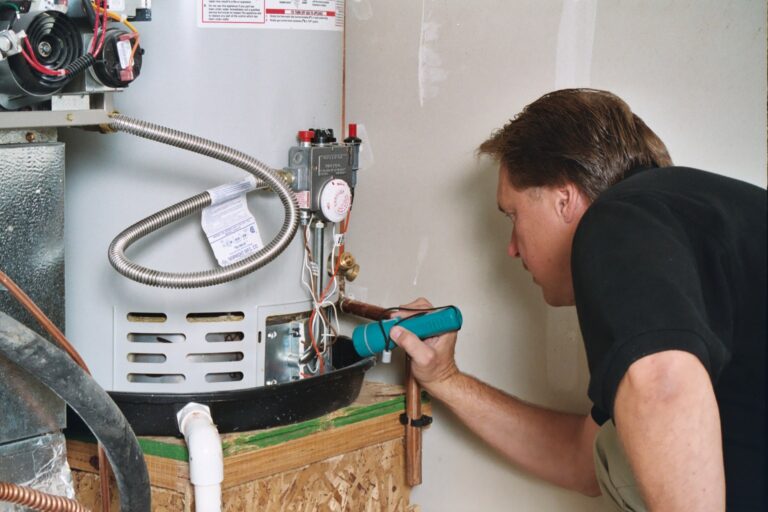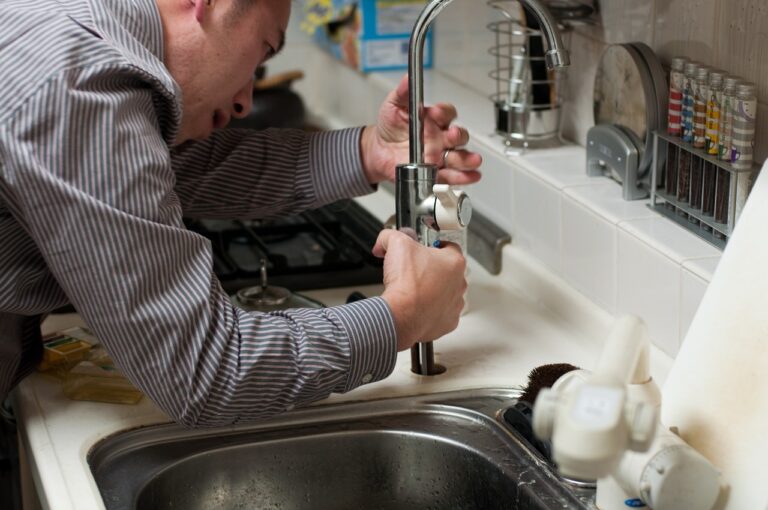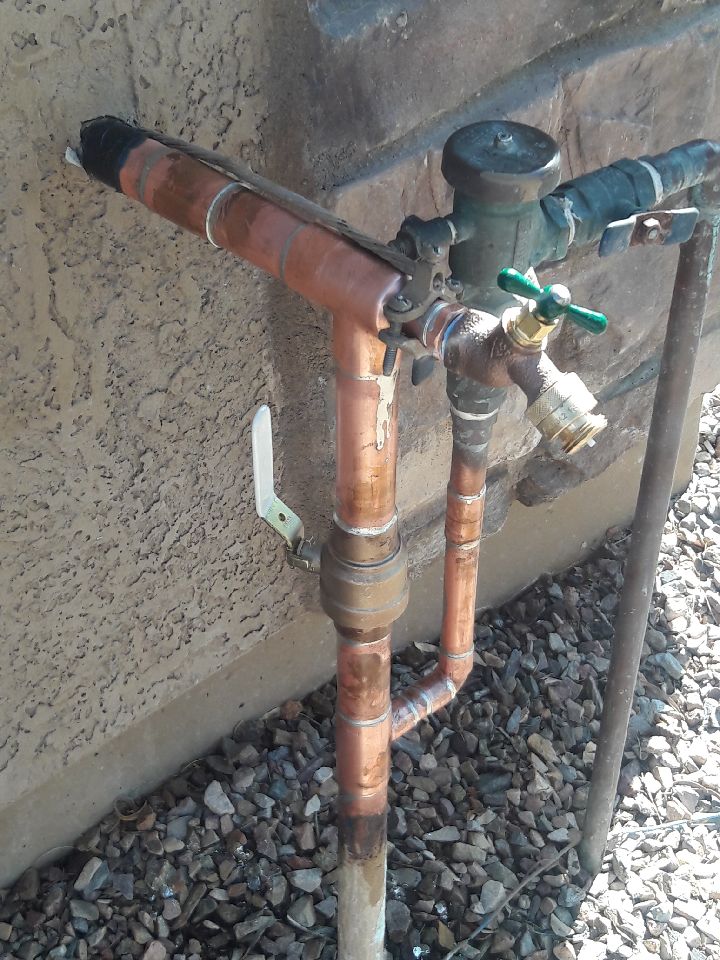What Causes Low Water Pressure in the Shower? Common Plumbing Fixes
Imagine you’ve had a long day and just want to relax in a shower. But instead, you get a weak trickle. This is often a sign of a plumbing issue that needs fixing.
Low water pressure can really mess up your day. But, knowing the common causes and how to fix them can help. This way, you can get your shower working right again.
This article will show you what usually causes low shower pressure. It will also give you easy tips to fix it and get your shower back to normal.
Understanding Low Water Pressure in Showers
Low water pressure in the shower can be frustrating. But knowing why it happens can help fix it. This problem makes showering less fun because the water flow is weak.
What is Low Water Pressure?
Low water pressure means the water from your showerhead or faucet is not strong. It can happen for many reasons. These include problems with the water supply, plumbing issues, or problems with the showerhead or faucet. As a note make sure you always get expert shower installation services if you are putting in a new shower.
Common Symptoms to Identify
It’s important to know the signs of low water pressure. Look out for:
- A noticeable decrease in water flow from the showerhead.
- Water trickling or dribbling from faucets.
- Longer times to fill bathtubs or buckets.
- Inconsistent water pressure, where the flow changes unexpectedly.
Spotting these signs early can help fix shower water pressure problems before they get worse.
Impact on Daily Routine
Low water pressure can really mess up your day. It affects not just how clean you get but also how comfortable you feel. For example, a weak shower makes it hard to wash off soap or shampoo.
It also makes appliances work less well. This can lead to using more energy or water.
Understanding why and how low water pressure affects us is key. By finding the cause, we can fix it. This improves our daily lives and makes bathing more enjoyable.
Possible Causes of Low Water Pressure
Low water pressure in showers can come from many sources. It might be due to supply problems or issues with the fixtures themselves. Knowing what causes it helps fix the problem.
Main Supply Issues
One big reason for low water pressure is the main water supply. This includes issues with the municipal water supply or high demand at certain times. Also, if the main shut-off valve is not fully open, it can lower the pressure a lot.
- Municipal supply issues
- Partially closed main shut-off valves
- Leaks in the main supply line
Plumbing Design Factors
The design of your plumbing system can also affect water pressure. For example, undersized pipes can limit water flow, causing low pressure. The layout of the plumbing system, including bends and fittings, can also reduce pressure due to friction loss.

Fixture-Related Problems
Often, the problem is with the fixtures themselves. Clogged showerheads and faucets can block water flow because of mineral buildup. Also, low-flow fixtures are made to save water but can lead to lower pressure.
“Regular maintenance of fixtures can significantly improve water pressure.”
To boost shower water pressure, check and clean fixtures often. Also, look into and fix any main supply and plumbing design issues. This can help solve low water pressure problems in bathrooms.
Water Pressure Measurement Techniques
Figuring out low water pressure starts with knowing how to measure it well. First, check if the low pressure is in one spot or everywhere. This helps find out if it’s a big problem or just a small one.
Tools for Measuring Water Pressure
To measure water pressure, you need a few basic tools. A pressure gauge is key. It attaches to a hose bib or faucet and shows the water pressure in pounds per square inch (PSI).
Choose a pressure gauge that’s easy to read and built to last. Some gauges have extra features like backlit displays or memory recall. These can help track changes in water pressure over time.
Ideal Water Pressure Range for Showers
The best water pressure for showers is between 30 and 80 PSI. This range is usually safe for most plumbing, including showerheads. But, the perfect pressure might differ based on your shower system’s needs.
“Water pressure that’s too low can result in a disappointing shower experience, while pressure that’s too high can lead to leaks and damage to your plumbing system.”
| Pressure Range (PSI) | Description |
|---|---|
| Below 30 | Low pressure, potentially causing weak water flow |
| 30-80 | Ideal range for most shower systems |
| Above 80 | High pressure, potentially causing leaks or damage |
How to Perform a Simple Test
To do a simple water pressure test, attach a pressure gauge to a hose bib or faucet. Take a reading. Make sure all other water sources in the house are off to get an accurate reading.
After attaching the gauge, turn on the water supply. Note the pressure reading. If it’s not in the ideal range, you might need to fix your plumbing or get help from a pro.
Knowing how to measure and understand water pressure is the first step to fixing low shower water pressure. It helps you tackle issues with your shower head.
Municipal Water Supply Problems
Problems with your city’s water supply can cause low water pressure in your shower. The system is complex, with many pipes, pumps, and treatment facilities. These work together to bring water to homes.
Understanding Water Supply Infrastructure
The system that brings water to your home is huge and complex. It includes water treatment plants, pumping stations, and underground pipes. Issues like a main break or pump failure can lower water pressure.
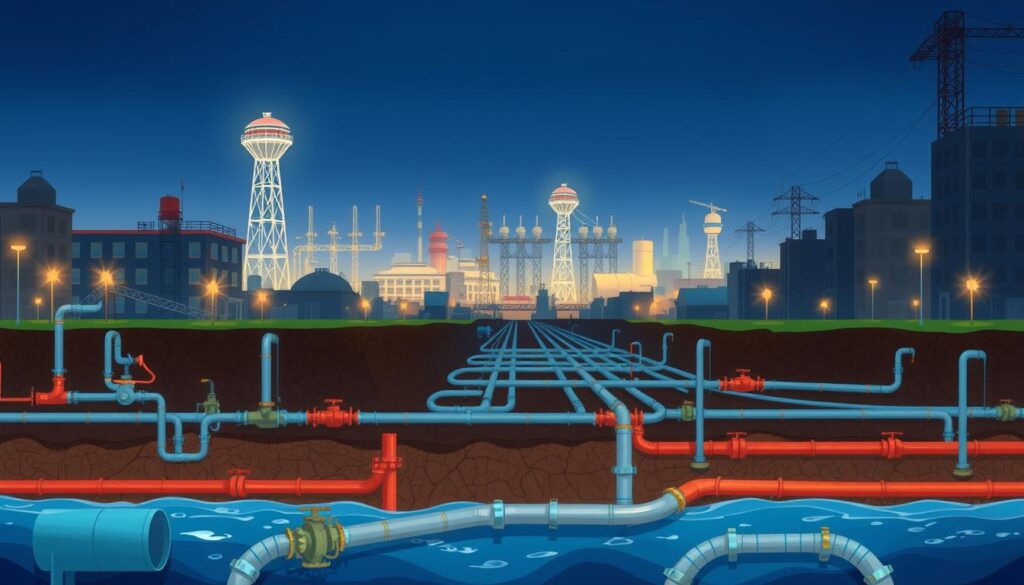
Seasonal Variations and their Effects
Seasonal changes can affect the water supply and pressure. For example, in summer, more water is used for gardening and outdoor activities. This can lower the pressure. In winter, freezing temperatures can cause pipes to burst, affecting the supply.
| Season | Common Issues | Effect on Water Pressure |
|---|---|---|
| Summer | High demand, possible drought | Lower pressure due to increased usage |
| Winter | Pipe bursts from freezing | Reduced pressure due to leaks and main breaks |
| Spring/Autumn | Maintenance and repair activities | Temporary pressure drops during work |
Reporting Issues to Your Water Provider
If you think municipal water supply issues are causing low water pressure, report it to your water provider. They can check and fix any problems. Keep a record of your issues, including dates and times, to help when reporting.
To fix low water pressure in shower, finding the cause is important. If it’s a municipal supply problem, working with your water provider is a key step to solving it.
Clogged Showerheads and Faucets
Minerals in showerheads and faucets can cause low water pressure. Over time, these minerals block the small openings in showerheads. This greatly reduces water flow and pressure.
How Mineral Buildup Affects Water Flow
Mineral buildup, often from hard water, can lower water pressure a lot. Minerals like calcium and lime scale block water flow paths. This makes the pressure drop.
Common signs of mineral buildup include:
- Reduced water flow
- Inconsistent water pressure
- Visible mineral deposits or scaling
Cleaning Tips for Showerheads
Cleaning your showerhead can fix low water pressure. Soaking it in vinegar and water can dissolve mineral buildup.
A step-by-step guide to cleaning your showerhead:
- Remove the showerhead from the shower arm.
- Soak it in a plastic bag filled with vinegar for several hours or overnight.
- Scrub away any remaining mineral deposits with a soft brush.
- Rinse thoroughly with water.
As
“Regular maintenance of showerheads can significantly improve water pressure and overall shower experience.”
When to Replace Kitchen or Bathroom Faucets
If cleaning doesn’t work, it might be time for a new faucet. Faucets with many clogged aerators or corroded parts can’t be fixed by cleaning.
Signs that indicate it’s time to replace your faucet:
- Persistent low water pressure despite cleaning
- Visible corrosion or damage
- Leaks or drips that cannot be fixed
Getting a new faucet can solve low water pressure problems. It also makes your kitchen or bathroom work better.
Pipe Size and Condition
Pipe size and condition are often overlooked but greatly affect shower water pressure. The plumbing system’s setup is key to delivering water at the right pressure. Knowing how pipe size and condition impact water pressure is vital for homeowners tackling shower water pressure problems.
Importance of Pipe Diameter
The diameter of your pipes directly affects water pressure. Narrower pipes restrict water flow, causing lower pressure. Wider pipes allow for smoother flow, potentially increasing pressure. It’s important to ensure your plumbing system has pipes that match your home’s water needs.
Effects of Age and Corrosion
Over time, pipes can deteriorate from age and corrosion, more so if they’re metal. Corrosion can narrow the pipe’s diameter, reducing water flow and pressure. Old pipes may need to be replaced or upgraded to keep water pressure optimal.
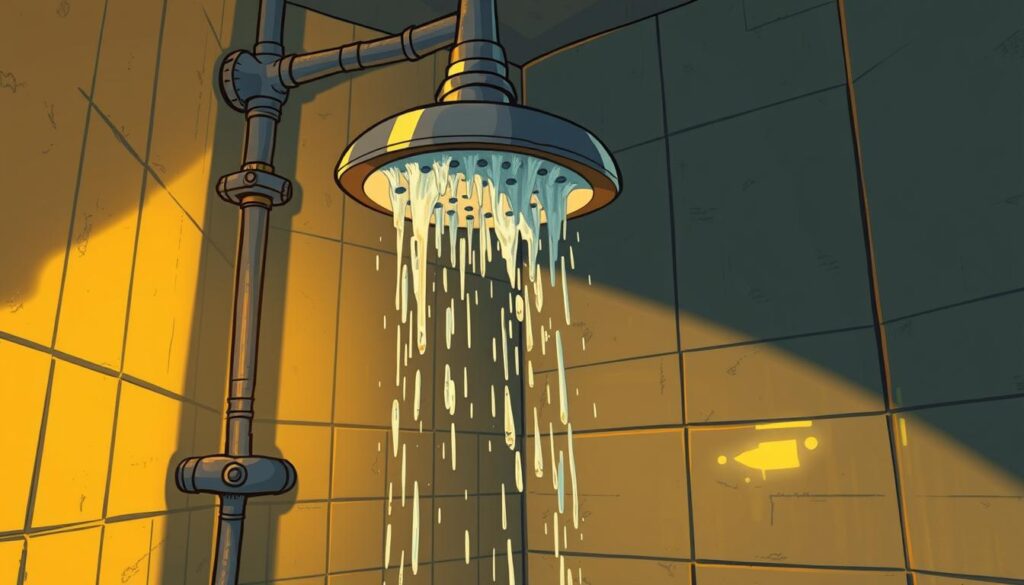
Upgrading Pipes for Better Pressure
If your pipes are old or too narrow, upgrading them can boost shower water pressure. Replacing old pipes with new, appropriately sized ones can greatly improve water flow and pressure. Homeowners should consult a professional plumber to assess their plumbing and suggest upgrades.
By understanding and addressing pipe size and condition issues, homeowners can make a big step towards fixing shower water pressure problems. This improves their overall shower experience, teaching them how to enhance shower water pressure. You need to make sure you are using trusted plumbers to do all shower repair & installation work.
Pressure Regulators and Valves
Pressure regulators are key to keeping water pressure right in your home. They make sure the pressure stays safe, which helps avoid pipe and fixture damage.
What is a Water Pressure Regulator?
A water pressure regulator controls your home’s water pressure. It lowers the pressure from the city supply to a safe level. This protects your plumbing, appliances, and fixtures from high pressure damage.
Key functions of a water pressure regulator include:
- Reducing high water pressure to a safe level
- Preventing damage to pipes, fixtures, and appliances
- Ensuring consistent water pressure throughout the home
How to Adjust Your Regulator
Adjusting your water pressure regulator needs care and the right tools. First, find the regulator near the water meter or where the water line enters your home. To change the pressure, loosen the lock nut and turn the screw clockwise to increase or counterclockwise to decrease. Use a pressure gauge to check the pressure before and after adjustments.
Important steps to follow:
- Turn off the main water supply before making adjustments
- Loosen the lock nut on the regulator
- Turn the adjustment screw as needed
- Check the pressure with a gauge and make further adjustments as necessary
Knowing When to Replace Your Regulator
If your water pressure regulator is faulty or damaged, it may not work right. This can lead to low water pressure in your bathroom or other areas. Signs it needs replacing include inconsistent pressure, leaks, or corrosion.
Consider replacing your regulator if you notice:
- Persistent issues with low water pressure
- Leaks or corrosion on the regulator
- Age of the regulator (typically, regulators last between 5 to 10 years)
Checking the regulator is part of troubleshooting low water pressure. Making sure it works well is key to keeping water pressure optimal.
The Role of Water Softeners
Water softeners and water pressure have a complex relationship. Knowing this is key to fixing low pressure. Water softeners remove minerals that make water hard. But, they can sometimes affect water flow in pipes.
How Water Softeners Can Impact Pressure
Water softeners remove calcium and magnesium ions. This prevents scale buildup in pipes. But, if not maintained, they can cause low water pressure. For example, fouled resin or dirty brine tanks can restrict water flow.
Key factors that influence water pressure when using a water softener include:
- The type of water softener used
- The level of maintenance performed on the softener
- The overall condition of the household plumbing system
Adjustments for Optimal Performance
To avoid water pressure issues, regular adjustments and maintenance are key. Check the softener’s settings to ensure it’s not too restrictive. Also, clean or replace parts as needed.
Some tips for optimal performance include:
- Regularly check and clean the brine tank
- Ensure the resin is in good condition
- Adjust the softener’s regeneration cycle to minimize pressure impact
Signs Your Softener Needs Maintenance
Decreased water pressure might mean your softener needs maintenance. Other signs include:
| Signs | Description |
|---|---|
| Reduced Water Pressure | A noticeable decrease in water pressure could indicate a problem with the water softener. |
| Scale Buildup | Visible scale buildup around faucets or showerheads may suggest the softener is not functioning correctly. |
| Soap Scum | Excessive soap scum on skin or shower surfaces can indicate hard water, suggesting the softener is not working effectively. |
Understanding water softeners and maintaining them properly ensures good water pressure. Regular checks and adjustments can greatly improve water flow and system performance.
DIY Solutions for Low Water Pressure
Low water pressure in the shower can be really frustrating. But, there are DIY solutions you can try before calling a pro. It’s important to know what’s causing the problem to find the right fix.
Simple Fixes You Can Try
Cleaning or replacing your showerhead is a simple start. Mineral buildup can cut down water flow a lot. Soaking the showerhead in vinegar can help get rid of these minerals and boost the pressure.
Another easy fix is to check and adjust the shut-off valves. Sometimes, these valves are not fully open. This can really lower the water pressure.
When to Call a Professional
If simple fixes don’t work, it’s time to call a pro. Problems like corroded or clogged pipes need special tools and skills.
A plumber can find the problem and fix it. They might need to replace old pipes or adjust your water pressure regulator.
Preventative Maintenance Tips
Regular maintenance can stop low water pressure problems. Check your showerhead and faucet for mineral buildup. Clean or replace them as needed to keep water pressure up.
Also, look for signs of corrosion or leaks in your pipes. Catching these issues early can prevent bigger problems later.
| DIY Fix | Description | Benefit |
|---|---|---|
| Clean or Replace Showerhead | Remove mineral buildup by soaking in vinegar or replace if necessary | Improved water flow and pressure |
| Check Shut-off Valves | Ensure valves are fully open | Restores full water pressure |
| Inspect Pipes | Look for corrosion or leaks | Prevents future pressure issues |
Conclusion: Resolving Low Water Pressure in Showers
Fixing low water pressure in showers means knowing why it happens and how to fix it. We’ve looked at many reasons, like bad water supply, clogged showerheads, and pipe issues.
Key Takeaways for Better Shower Experience
To get better water pressure, find out what’s causing the problem. You might need to adjust or replace pressure regulators, clean or change clogged showerheads, or upgrade pipes. Regular checks for mineral buildup and pipe condition can also help.
Maintaining Optimal Water Pressure
By using what we’ve learned, you can make your showers better. Keeping your plumbing in check is key to good water pressure. If problems persist, a professional plumber can offer specific solutions.
Take Action for Better Water Pressure
Don’t let low water pressure ruin your day. Start by checking your plumbing and fixing what’s wrong. With the right steps, your showers will be refreshing and rejuvenating every time.
